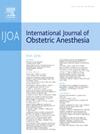Low dose intrathecal morphine for post-cesarean analgesia with scheduled multimodal pain regimen: a prospective, randomized, open blinded end-point study
IF 2.6
3区 医学
Q2 ANESTHESIOLOGY
引用次数: 0
Abstract
Background
The intrathecal morphine dose in combination with multimodal analgesia providing optimal pain management post-cesarean delivery while minimizing side effects has not been determined. We performed a prospective, randomized, open blinded end-point study comparing intrathecal morphine 50 μg vs. 100 μg combined with scheduled intravenous ketorolac and oral acetaminophen for post-cesarean delivery analgesia.
Methods
Participants received intrathecal hyperbaric bupivacaine 12 mg, fentanyl 15 µg and a randomized dose of intrathecal morphine 50 μg vs. 100 μg followed by intravenous ketorolac 30 mg every six hours and oral acetaminophen 1000 mg every eight hours for the first 24 hours. Oral oxycodone and intravenous morphine were administered based on pain scores. The primary outcome was time to first analgesic request (opioid rescue dose) in the first 24 hours, analyzed using intent to treat and the hypothesis of non-inferiority using a log-rank testing approach and assuming a non-inferiority margin of a hazard ratio of 1.65.
Results
There were 201 participants randomized to intrathecal morphine 50 μg vs. 100 μg. The median time to first rescue dose was 23.5 hours postoperatively for the 50 μg cohort (95% CI 15.2, 28.3) and 22.9 hours postoperatively with the 100 μg cohort (95% CI 13.8, 28.2). The probability of requesting an opioid rescue dose was similar between the two treatment groups during the first 24 hours. Postoperative pruritus, nausea, vomiting, total opioids used, pain at rest and with ambulation, and time to first ambulation were not different between the two cohorts.
Conclusion
With ketorolac and acetaminophen, intrathecal morphine 50 μg was not inferior to 100 μg evaluating time to first opioid rescue dose and opioid use over time. There were no differences in secondary outcomes.
背景尚未确定鞘内吗啡剂量与多模式镇痛相结合,在最大程度减少副作用的同时提供最佳的剖宫产后疼痛管理。我们进行了一项前瞻性、随机、开放盲法终点研究,比较了鞘内吗啡 50 μg 与 100 μg 联合计划静脉注射酮咯酸和口服对乙酰氨基酚用于剖宫产术后镇痛的效果。方法参试者接受鞘内高压布比卡因 12 毫克、芬太尼 15 微克和随机剂量的鞘内吗啡 50 微克 vs. 100 微克,然后在头 24 小时内每 6 小时静脉注射酮咯酸 30 毫克,每 8 小时口服对乙酰氨基酚 1000 毫克。根据疼痛评分给予口服羟考酮和静脉注射吗啡。主要结果是头24小时内首次申请镇痛药(阿片类药物救援剂量)的时间,采用意向治疗和非劣效性假设进行分析,使用对数秩检验法,并假设非劣效性边际为危险比1.65。结果201名参与者随机接受鞘内吗啡50微克与100微克的治疗。50 μg组患者术后首次抢救用药的中位时间为23.5小时(95% CI为15.2-28.3),100 μg组患者术后首次抢救用药的中位时间为22.9小时(95% CI为13.8-28.2)。在最初的 24 小时内,两组患者申请阿片类药物救援剂量的概率相似。结论在使用酮咯酸和对乙酰氨基酚的情况下,鞘内吗啡50微克在评估首次使用阿片类药物抢救剂量的时间和阿片类药物使用时间方面并不逊色于100微克。次要结果无差异。
本文章由计算机程序翻译,如有差异,请以英文原文为准。
求助全文
约1分钟内获得全文
求助全文
来源期刊
CiteScore
4.70
自引率
7.10%
发文量
285
审稿时长
58 days
期刊介绍:
The International Journal of Obstetric Anesthesia is the only journal publishing original articles devoted exclusively to obstetric anesthesia and bringing together all three of its principal components; anesthesia care for operative delivery and the perioperative period, pain relief in labour and care of the critically ill obstetric patient.
• Original research (both clinical and laboratory), short reports and case reports will be considered.
• The journal also publishes invited review articles and debates on topical and controversial subjects in the area of obstetric anesthesia.
• Articles on related topics such as perinatal physiology and pharmacology and all subjects of importance to obstetric anaesthetists/anesthesiologists are also welcome.
The journal is peer-reviewed by international experts. Scholarship is stressed to include the focus on discovery, application of knowledge across fields, and informing the medical community. Through the peer-review process, we hope to attest to the quality of scholarships and guide the Journal to extend and transform knowledge in this important and expanding area.

 求助内容:
求助内容: 应助结果提醒方式:
应助结果提醒方式:


